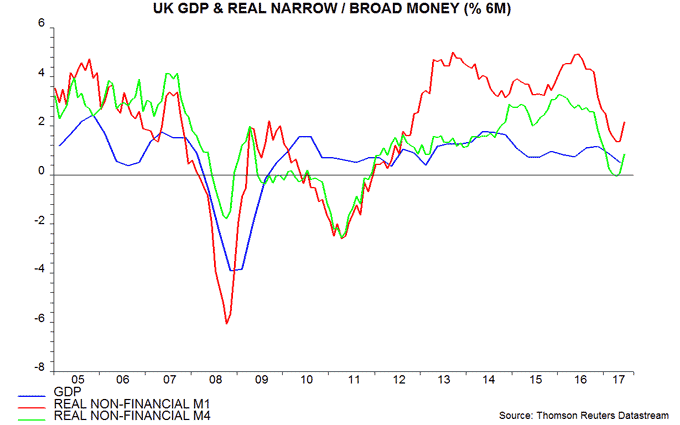Entries from July 30, 2017 - August 5, 2017
UK MPC more pessimistic about supply growth
A key take-away from the UK August Inflation Report is that the MPC has lowered its estimate of potential GDP growth to only about 0.4% per quarter. With the economy judged to be operating close to full capacity, a rebound in actual quarterly growth to above 0.4% could be sufficient to trigger an early rate hike.
GDP growth is now forecast at 1.7% in 2017 and 1.6% in 2018 versus 1.9% and 1.7% respectively in May. The downgrade partly reflects higher interest rates: the average level of Bank rate in 2018 implied by the market curve is 15 basis points higher than in May. Despite weaker growth, however, the three-year ahead inflation forecast is essentially unchanged – 2.22% versus 2.26% in May. Softer demand, in other words, is balanced by weaker potential growth.
The increased pessimism about supply-side potential is shown more clearly by inflation forecast based on an unchanged 0.25% Bank rate – the three-year ahead projection of 2.47% is up from 2.36% in May.
According to the latest policy statement, “GDP growth remains sluggish in the near term …” but “… picks up to just above its reduced potential rate over the balance of the forecast period”. GDP growth is projected at 1.8% at the end of the forecast so this suggests potential expansion of 1.6-1.7%, or about 0.4% per quarter.
The MPC expects quarterly GDP growth to remain at 0.3% in the third quarter before picking up slightly at the end of the year. A rebound to 0.5%, therefore, could be sufficient to persuade several more members to vote for an early hike.
Monetary trends are giving a more hopeful message for economic prospects: six-month growth of real narrow and broad money recovered significantly in June, reflecting a combination of stronger nominal expansion and a moderation of six-month inflation – see chart.
G7 money surge suggesting too-loose policies
Six-month growth of global real narrow money* continued to strengthen in June, signalling a likely pick-up in economic momentum in late 2017 / early 2018, after a modest near-term slowdown. Monetary acceleration suggests that major central banks are falling further “behind the curve” and will be forced to tighten policies significantly as economic growth and inflation rebound.
Six-month growth of global (i.e. G7 plus emerging E7) real narrow money, adjusted for Indian demonetisation, bottomed in February 2017, rising for a fourth consecutive month in June to its highest since September 2016. Allowing for an average nine-month lead, this suggests that six-month industrial output growth will strengthen from around November – see first chart.
Economic momentum is likely to moderate shorter term, reflecting a fall in real narrow money growth between August 2016 and February. This is also the message from the global leading indicator tracked here: it typically leads by four to five months and its six-month growth declined again in June**. The one-month change in the indicator, however, rose for a second month, suggesting an imminent turn in the six-month measure – second chart. Such a turn would confirm the signal of economic reacceleration from late 2017 from monetary trends.
Coincident economic news remains mostly solid but is cooling at the margin. The Citigroup G10 economic surprise index turned significantly negative in June and has remained weak – third chart. The global manufacturing business survey indicator tracked here ticked down in July, while the MSCI All-Country World Index earnings revisions ratio was negative for a second month – fourth chart. The Euroland ratio has reversed particularly sharply, partly reflecting the strong euro, consistent with the expectation here of weaker economic news – fifth chart.


The pick-up in global real narrow money growth has been led by the G7 and the US in particular. G7 real money growth is now well above the India-adjusted E7 level, questioning the sustainability of recent EM asset outperformance – sixth chart. E7 real money growth is respectable in absolute terms but has been held back by moderating – though still solid – Chinese expansion and a contraction in Mexico following recent significant monetary policy tightening.
*Narrow money = currency in circulation plus demand / overnight deposits. Financial sector holdings excluded where possible. Real = deflated by consumer prices, seasonally adjusted.
**June estimate based on partial data.

